The week at a glance
- Wood Duck on Shetland
- White-throated Sparrow in Hampshire
- Zitting Cisticolas still on Guernsey
- Potential Glaucous-winged Gull in London
There were sunshine and warmer temperatures for many this week although some parts of the country (chunks of the east coast for instance) were often cool to almost chilly under a veil of grey skies and sea fret. It being mid-April, birds began to arrive whatever, as several "firsts of the year" made landfall over the course of the week.
And talking of "firsts", what about the handsome drake Wood Duck that was discovered on Loch of Brow (mainland Shetland) on 16th? Long predicted as a candidate for admission to the British List, this common Nearctic duck has never yet provided a suitable candidate for the BOURC to say "ok, we like this one" (despite the odd one which looked great on paper). This may well be the one that tips the balance in favour of the Aix. The usual boxes were swiftly ticked off (wary, fully-winged and unringed) and it is a grand time of year to have American wildfowl heading northwards from wherever they have wintered. Indeed Shetland in April has a little bit of recent history as far as "mega" ducks: the dazzling drake Hooded Merganser that spent a couple of weeks on Unst in 2006 arrived on April 15th of that year. Sure there are always counter-arguments (just because it is Shetland it doesn't automatically mean it's wild — see various Chestnut Buntings, Daurian Starling, Yellow-headed Blackbird and so on) but weigh it all up and this has to be a contender. He was last seen on 20th. The cracking first-summer male White-throated Sparrow continued to sing away at Old Winchester Hill (Hampshire) until 20th, often feeding happily on a seeded area set aside by the on-site staff — all's well that ends well, thank goodness. On Guernsey, the two Zitting Cisticolas were still at Port Soif to 19th; hopes are still high that the island's first breeding record may be coming sooner rather than later. After last week's probable in Dumfries & Galloway, it was London's turn to go after a Glaucous-winged Gull this week. A first-winter bird (either the full monty or hybrid) was seen at Beddington SF on 21st–22nd (of course, it could be a second for the site if proven). At first, the bird was named as a possible hybrid Glaucous Gull × Herring Gull, then possibly a Glaucous Gull × American Herring Gull, before revised thoughts suggested that it could actually be the Western Palearctic's first first-winter Glaucous-winged Gull. It transpired that the same bird had been seen the evening before at Queen Mother Reservoir (Berkshire) and it quickly became clear that this bird had been seen at several localities around London and the Home Counties from early February and, although queried at all sites (there were at least four), the then fully juvenile bird evaded specific identification. Now, as a first-winter bird, it does indeed look rather like a Glaucous-winged Gull. If it isn't one, what hybrid type could it be? The debate has already begun.
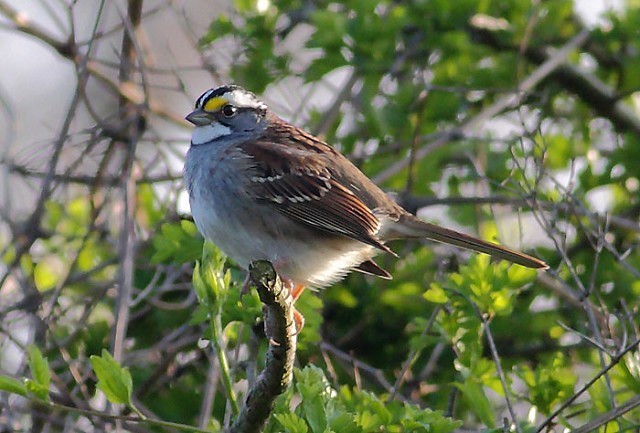
White-throated Sparrow, Old Winchester Hill, Hampshire (Photo: James Packer)
The White-billed Diver remained on Little Loch Broom, Camusnagaul, near Ullapool (Highland) to 17th and on the Outer Hebrides two birds were seen off Tolsta Head and Port Nis, Lewis, on 18th and 19th respectively. Just under 20 Pomarine Skuas were seen at several localities this week. These were County Cork, the Outer Hebrides, Dumfries & Galloway, Cumbria, Essex, Hampshire and West Sussex; the latter county saw four fly past Selsey Bill on 18th and four were seen from Annan and Seafield (Dumfries & Galloway) on 21st. Two single Sabine's Gulls were reported from Cornish headlands this week: one was off Lizard Point on 16th and the following day one was seen off Porthgwarra.
Three Cattle Egrets were again near Skewjack (Cornwall) on 19th and two were near Polgigga the following day with a single bird at Land's End on 22nd. Another single bird was still at Yelland (Devon) for much of the week. In Cheshire, the Cattle Egret was still at Bradley, while a new arrival was at Rye (East Sussex) on 19th. Up to four birds remained around White's Marsh (Co. Cork) in the early part of the week at least, and four were again around Inchydoney on 20th.
Two Great White Egrets flew over Coward's Marsh (Dorset) on 18th and one was again around the Ouse Washes (Cambridgeshire) on the same date. Earlier in the week, a Great White Egret was at Mickle Mere (Suffolk) and further birds were reported from Allhallows-on-Sea (Kent), Frinton-on-Sea (Essex) and Rainham Marshes (London). The long-staying bird at Gilmourton (Clyde) was present to 20th at least. Up to 21 Spoonbills this week included strays on the Cob Pool (Anglesey) and at Spurn (East Yorkshire) on 18th, the latter perhaps accounting for the individual that was seen in Northumberland (over the Farnes and at East Chevington) the following day. Also on 19th, a Spoonbill was at Loch of Strathbeg (Aberdeenshire) and two were at both Inner Marsh Farm (Cheshire) and Grove Ferry (Kent).
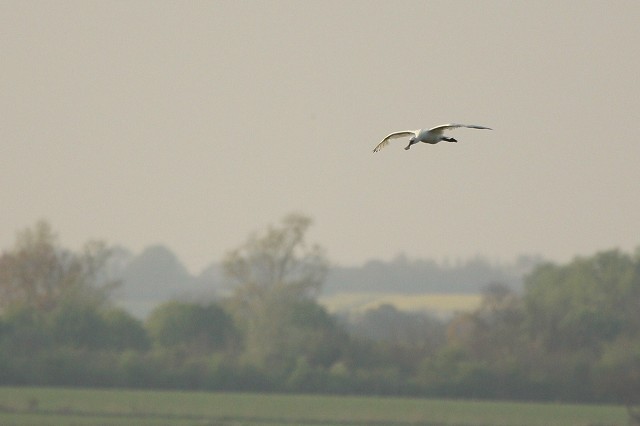
Spoonbill, Old Hall Marshes RSPB, Essex (Photo: Mark Bicknell)
A few Common Cranes went a-wanderin' this week — quite how many were involved is hard to say, but some can be tied in together as the same birds. First up the "Blacktoft Five", seen flying southwest over the East Yorkshire reserve on 18th. Later that day, they alighted at Gibraltar Point (Lincolnshire) before departing towards Norfolk the following morning. Sure enough, five Cranes were seen over Holme half an hour after they left Lincolnshire. Another group of five birds over Carlton Colville (Suffolk) on 18th presumably came from the Broads. It is also tempting to link two birds in Shropshire on 17th and Worcestershire and the West Midlands on 18th as being "two and the same", while the bird at Wareham (Dorset) on 18th may well have been the bird in Hampshire on 19th (the bird in West Sussex on 18th–19th is presumably different again). Also on 19th a Crane was seen near Haverhill (Suffolk), while much further north singles were seen at Port Nis, Lewis (Outer Hebrides) and Baltasound, Unst (Shetland) and three birds were seen over Loch of Strathbeg on 20th. The 21st saw four Cranes head along the north Norfolk coast between Cley and Sheringham and, still in Norfolk, two were seen near Gateley on 22nd. Also on 22nd, one was at Sudbury (Suffolk).

Common Crane, Blacktoft Sands RSPB, East Yorkshire (Photo: anon)
A ringed White Stork was at Mersehead (Dumfries & Galloway) on 16th–17th, with others at Brecon (Powys) on 16th and Frampton (Dorset) on 17th. One was reported over Broughton (Buckinghamshire) on 18th, while a probable White Stork was over Connah's Quay (Clwyd) on 19th. On 22nd, single White Storks were seen at Bridge of Allan (Forth) and Wilstone Reservoir (Hertfordshire). In Suffolk, an adult Purple Heron was at Boyton Marshes on 16th and this was followed by an adult reported back at Oxley Marshes the following day. Somewhat confusingly, on 18th, an adult was reported from Oxley, then a first-summer bird was listed as "still there" and then a non-adult was reported flying past Hollesley the same day (though a local website lists all sightings as being of an adult). By 20th, an adult was back at Boyton and it seems as though only one bird is involved.
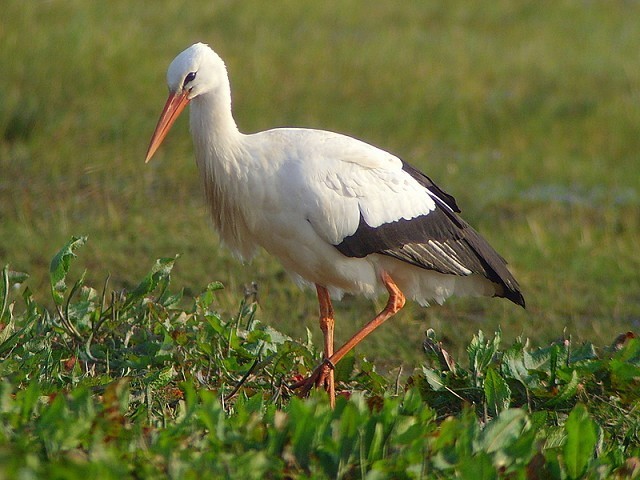
White Stork, Mersehead RSPB, Dumfries & Galloway (Photo: John Nadin)

White Stork, Mersehead RSPB, Dumfries & Galloway (Photo: Brian Henderson)
The blue-and-white Snow Geese remained at Loch of Strathbeg to 22nd, while up to three Black Brants were seen in Norfolk this week: at Snettisham on 16th, near Blakeney on 17th and at Titchwell on 22nd. A Taverner's Canada Goose was at Caerlaverock (Dumfries & Galloway) on 21st.
The female Lesser Scaup was at Clea Lakes (Co. Down) on 16th (it was last reported on 22nd February) and the first-winter drake was still in Cardiff Bay (Glamorgan) to 18th. The adult drake remained at Blair Drummond (Forth) to 18th while the bird at Hornsea Mere (East Yorkshire) was still present to 22nd (and the hybrid issue, originally raised last week, cropped up again). A female Ring-necked Duck was at Allcot Sugar Factory lagoons (Shropshire) on 16th–18th and two drakes were at Loch Kinord (Aberdeenshire) on 19th–20th. Regulars included drakes on Otmoor (Oxfordshire), Loch an Eilien, Tiree (Argyll), Loch Calder (Highland), Loch of Tingwall (Shetland) and Oxford Island (Co. Armagh) and two females remained on Vartry Reservoir (Co. Wicklow). Single females were still at Cross Lough, Killadoon (Co. Mayo), Martanham Loch (Ayrshire) and Swineham GPs (Dorset) — funnily enough, the latter site was host to a drake Wood Duck on 14th.
A drake Blue-winged Teal was seen at Reddan's Lough (Co. Tipperary) on 22nd, while there was very little change in terms of Green-winged Teal this week, single drakes remaining at Eyebrook Reservoir (Leicestershire), Greenabella Marsh (Cleveland), Errol (Perth & Kinross) and Shannon Airport Lagoons (Co. Clare), while one was seen again at Inner Marsh Farm on 16th–17th. A new bird was seen near King's Lynn (Norfolk) on 20th–21st. The drake American Wigeon remained on the Ythan Estuary (Aberdeenshire) between 17th and 19th at least. Single drake Surf Scoters remained off Ruddon's Point (Fife), Ferny Ness (Lothian) and Rerwick Head, Mainland (Orkney) during the week, with two drakes at the latter site on 20th. The drake Hooded Merganser was still at Radipole Lake (Dorset) to 22nd.
Raptor of the week (if proven to be wild) has to be the sub-adult Golden Eagle seen at Stithians Reservoir (Cornwall) on 19th. One or two released White-tailed Eagles were seen in Aberdeenshire and one was also in Perth & Kinross this week, while one or two Rough-legged Buzzards were seen in Cambridgeshire, at Grunty Fen on 18th and around Coveney until 20th at least. Another Rough-legged Buzzard was around Winterton and Horsey (Norfolk) on 20th–21st. A Black Kite was seen over St. Martin's (Scilly) on 16th, while in Kent single birds were seen over Margate on 20th and Westhanger and St. Margaret's at Cliffe on 22nd. The first Red-footed Falcon of spring was reported near Great Ashfield (Suffolk) on 17th and another Suffolk bird was at North Cove on 22nd. In Cornwall, a first-winter Snowy Owl was seen at Gwithian on 19th, over two weeks since it was last seen in the county. Where has it been in between times?
In Norfolk, the controversial "Lesser Golden Plover" at Breydon Water was still present on 17th–18th. After a pendulum swing towards American Golden Plover last week, new evidence was put forward as to why the bright-looking bird was actually a Pacific Golden Plover. Judging evidence from photographs alone is a dangerous business — nothing beats field observations (after all, you won't hear a call from an image on a computer screen). Ageing the bird correctly is vital in a situation like this to enable a correct identification and many still feel sure that the bird is a first-summer and therefore a dominica and not fulva. A male Kentish Plover was at Pegwell Bay (Kent) on 17th–18th and two birds were on the Hayle Estuary (Cornwall) on 19th. A Pectoral Sandpiper was at Loch Stiapavat, Lewis (Outer Hebrides) on 16th–20th and two birds were seen at Cossington Meadows (Leicestershire) on 20th–22nd. These three were followed by two more on 21st, at Slimbridge (Gloucestershire) and Pagham Harbour (West Sussex). The Lesser Yellowlegs at Heybridge Basin (Essex) reappeared on 18th, remaining to 22nd. The first Dotterels of the spring arrived on 16th, when two birds were seen at the Mull of Oa (Islay). Then, on 18th, singles were noted at Climping (West Sussex), Stoke-on-Trent (Staffordshire) and Wereham (Norfolk) and on 20th three birds were seen near Glanaman (Carmarthenshire). Another year first, a Temminck's Stint, was seen on St. Mary's (Scilly) on 21st–22nd.

Pectoral Sandpiper, Cossington Meadows LRWT, Leicestershire and Rutland (Photo: Howard Broughton)

Kentish Plover, Hayle Estuary, Cornwall (Photo: Duncan Jeggo)
The adult Bonaparte's Gull was at Farmoor Reservoir (Oxfordshire) on 16th–18th and another was seen at Tacumshin (Co. Wexford) on 18th. Two first-summer Caspian Gulls were seen at the London Wetland Centre on 17th.
Around 45 Iceland Gulls were seen around Britain and Ireland this week, including five at Kinnegar Pools (Co. Down) on 18th. The only Kumlien's Gulls of the week were the second-winter seen again at Blackborough End (Norfolk) on 18th (some three weeks after it was last reported there) and the first-winter at Rossaveal (Co. Galway) on 22nd. Numbers of Glaucous Gulls fell to just above double figures this week. Just three Ring-billed Gulls were reported over the week: a first-summer was at Loch Beg (Mull) on 18th and a first-winter was still in Northern Ireland, in Antrim, on the same day. The second-summer Ring-billed Gull was still at Lamby Lake (Glamorgan) on 20th. The adult summer Forster's Tern remained around Nimmo's Pier (Co. Galway) to 17th, with one (also an adult summer) at Tacumshin (Co. Wexford) on 22nd.

Iceland Gull, St. Mary's, Isles of Scilly (Photo: Joe Ray)
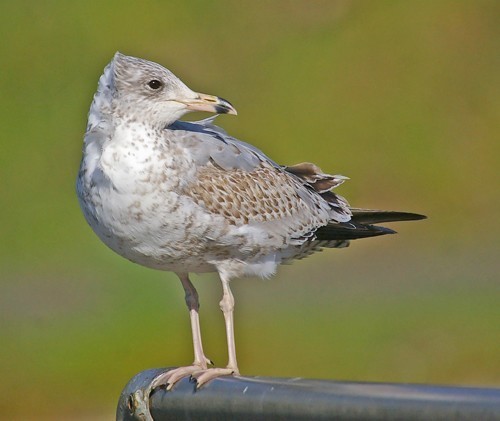
Ring-billed Gull, Antrim, Antrim (Photo: Derek Charles)
At least nine Hoopoes were seen over the week, the first appearing at Boulmer (Northumberland) on 16th and was followed by singles at Dungeness (Kent) and along the M23 near Redhill (Surrey) on 18th and birds on 19th at Portland (Dorset), Ballaghennie (Isle of Man), Old Head of Kinsale (Co. Cork). On 20th, a Hoopoe was seen at Upper Sheringham (Norfolk), and the following day one was seen briefly at Pebsham (East Sussex). The final Hoopoe of the week was seen near Doynton (Gloucestershire) on 22nd. On the Wirral, the Red-rumped Swallow seen last week at Moreton remained to 17th before moving to North Wirral CP on 18th and another was found on Fair Isle (Shetland) on 20th, the first here since one in June 2005. The third of the week was seen for five minutes at Andover (Hampshire) on 21st. An Alpine Swift flew over Bradwell-on-Sea (Essex) on 19th with another over Brightstone (Isle of Wight) the following day. A Wryneck was reported at Blakeney (Norfolk) on 17th, with another at Capel le Ferne (Kent) on 18th, while two were seen on Orkney this week, at Redland on 18th and on North Ronaldsay on 19th.

Hoopoe, Fort Doyle, Guernsey (Photo: M Lawlor)

Red-rumped Swallow, Moreton, Cheshire (Photo: Steve Seal)
The spring's first Short-toed Lark was found on St. Mary's (Scilly) on 20th, and 2009's first Woodchat Shrike arrived in the Cot Valley (Cornwall) on 18th and was followed by another in Ireland, at Ballydwan (Co. Waterford) on 21st. Just two Great Grey Shrikes were seen this week, at Langdale Forest (North Yorkshire) and Speech House (Gloucestershire). There were still well over 600 Waxwings dotted around the country this week, with a flock of around 120 Hillsborough (South Yorkshire) on 16th the largest group reported.
It was another decent week for Subalpine Warblers, with four birds seen over the past seven days. Three of them arrived on 18th. One was found at Spurn in East Yorkshire (the 22nd record for the Observatory recording area) with further males on Bardsey Island (Gwynedd) and Great Saltee Island (Co. Wexford). The Spurn bird remained to 20th at least, while the fourth of the week was found at Scatness (mainland Shetland) on 22nd. A singing male Siberian Chiffchaff was still at Westport Lake (Staffordshire) to 18th with another reported at Cosmeston Lakes CP (Glamorgan) on 20th. Rather more of a surprise was the male Red-breasted Flycatcher reported from Dungeness on 17th, though more details are hard to come by. Let's not forget that the only spring Taiga Flycatcher was an April bird.

Subalpine Warbler, Saltee Islands, Wexford (Photo: Tom Shevlin)
The round-up concludes with a couple of Serins: a female was at the Winspit Valley (Dorset) on 18th and a male was at Coverack (Cornwall) on the same date. A Little Bunting was found at Flamborough Head (East Yorkshire) on 22nd.
Photo of the Week

Marsh Harrier, Cley Marshes NWT, Norfolk (Photo:
Nigel Pye)
With the usual apologies for selecting gruesome images, we couldn't resist this week's shot by Nigel Pye of a Marsh Harrier carrying a rat. Keeping his composure as this amazing sight appeared before him in a Norfolk hide, Nigel did well to capture a series of images of the fly-past. Our selected image has frozen the pair at the perfect angle, reminiscent of an Osprey-carrying-fish shot, especially given the water in the background. The light has picked out the key details of both the harrier and its unfortunate victim, and the portrait format of the image has framed the subject well.

Gannet, Fife Ness, Fife (Photo:
John Anderson)

Fulmar, Russia (Asia) (Photo:
Penny Williams)

Black-necked Grebe, undisclosed site, West Yorkshire (Photo:
Matt Latham)

Lapwing, Cley Marshes NWT, Norfolk (Photo:
Richard Bedford)
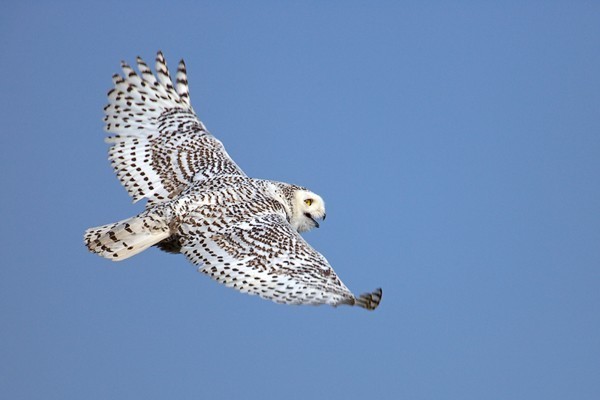
Snowy Owl, Lihou, Guernsey (Photo:
Steve Levrier)

Black-tailed Godwit, Cley Marshes NWT, Norfolk (Photo:
Amanda Hayes)

Common Kingfisher, undisclosed site, West Sussex (Photo:
Howard Kearley)

Hawfinch, Forest of Dean, Gloucestershire (Photo:
Mark Hancox)

Bullfinch, Milnthorpe, Cumbria (Photo:
Pauline Greenhalgh)

Ptarmigan, Cairn Gorm, Highland (Photo:
Marcus Conway)

Avocet, Marshside RSPB, Lancashire (Photo:
David Cookson)

Razorbill, Bempton Cliffs RSPB, East Yorkshire (Photo:
Dean Eades)

Moorhen, Cley Marshes NWT, Norfolk (Photo:
Amanda Hayes)

European Stonechat, East Tilbury, Essex (Photo:
Lea Roberts)

Nightingale, Paxton Pits NR, Cambridgeshire (Photo:
Dave Hutton)

Feral Pigeon/Rock Dove, East Walton, Norfolk (Photo:
Stephen Durrant)

Lesser Spotted Woodpecker, undisclosed site, Cheshire (Photo:
Steve Oakes, AEBS Limited)

